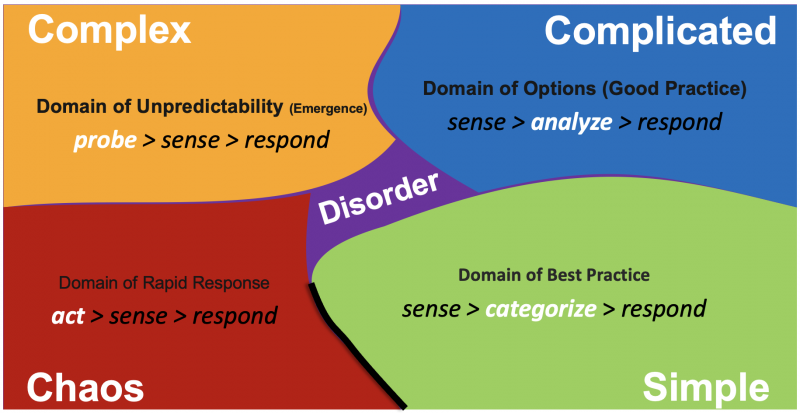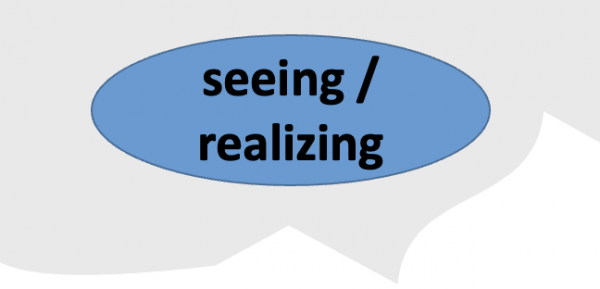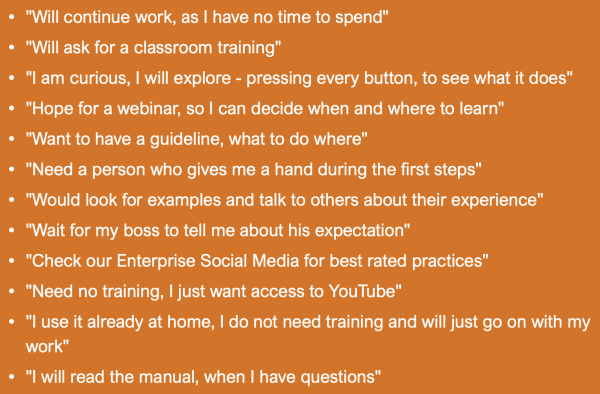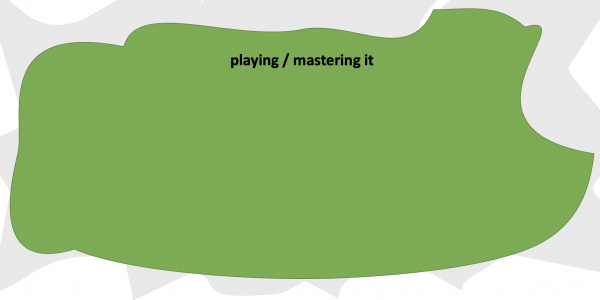
There is quite some material about complexity available – never-the-less it seems one of the biggest challenges to identify complex tasks or problems (and distinguish from complicated or simple ones) and even more to apply reasonable, fitting methods and formats. Today I want to exemplify my personal approach on leveraging the power of complexity.
In fact, often the opposite,
example: using command & control in a network will kill engagement
of what we used to do,
leads to success.
In my following post, I refer as a practical example task to a project assignment 2016, global scope, 60 countries, 25 new software tools, migration of data, ideally adoption of behavior to new opportunities. To focus, I concentrate only on the „learning“ part, which is of course highly integrated into the communication, change and support framework, we designed. Click here to jump directly to the example, if you know the background already
Why should I bother about complexity?
Definition of Complexity (by AI):
The definition of complexity is the state of being composed of interconnected parts or having intricate and convoluted connections or relationships that make it difficult to understand or explain. It can refer to the degree of sophistication, intricacy, or difficulty in a system, problem, or concept. Complexity can also describe the level of detail, variability, or unpredictability in a situation or phenomenon.
Or in simple language:
Complexity means something that is made up of many interconnected parts and is difficult to understand or explain. It can also refer to something that is very detailed, difficult, or unpredictable.
Simple Tasks

A simple business task has one perfect solution (best practice) – basically anyone can learn it, even so it might take practice. It can be perfectly described (process flow) and it can be optimized (lean) … in the end it is likely to be handed over to a software (algorithm) or a robot, as both can do it better (24/7, accuracy…) than any human. It does not need creativity, variations and is mostly a stand-alone event, which might be integrated into a sequence > process flow. The quality rating is also simple and can be measured on a linear scale – no matter where or from whom it is done.
Complicated Tasks

A complicated problem takes expertise and evaluating the frame conditions with some room for choices e.g. depending on the target groups, stakeholders or environment (good practice – it depends, what is best answer). Complicated tasks typically are a bigger set of simple tasks, which need to be put in the right order, with responsive priority and competent executers. A deeper knowledge and awareness of options or experience is helpful. Complicated tasks require taking choices or decisions at a time, which influences the outcome.
The classical hierarchical management and it’s formats, methods, tools and regulations are built on the idea to have the management solve complicated problems, simplifying it, so it can be delegated downwards to be executed by „less capable human resources“
Complex Tasks

If we are dealing with a complex task (The cynefin framework offers us great insights here and helps to distinguish between simple, complicated and complex), linear, classical top-down-one-size-fits-all solutions do not work.

Following this framework – and I experienced that many times in real live – applying a method of one domain (simple or complicated) to another (complex), it will fail or cause more harm than intended. This is very clear in physical (everyone wears different size cloth) but gets harder, once it is about leadership, emotions, psychological needs or „just getting the commitment from a group“.
Simplifying complex tasks will harm or destroy their possible outcome
WHY does simplification not work?
Most humans LOVE simple answers, yes/no, right/wrong, true/false, left/right or good/bad are simple categories, giving us the desired security or feedback to our actions. The majority of our „systems“ condition us for this simplification – here are some examples:
- kindergarden – clear definition of a house and how it looks
- school – multiple-choice tests, grades
- business – traffic light reporting, elevator pitch
- politics – either-or gap
The „living“ part of our world does not follow our idea of „simplified“ solutions
attempts to simplify nature (like mono-culture) resulted in big fails
Other than material, tools and products, which do not „change from themselves“, every living organism, nature and markets (as they are shaped by humans) is complex or shows complex behavior. It is rarely fully repetitive, it varies in many aspects, it surprises, it acts non-logical/emotional sometimes irrational. Even so the bigger pictures seems to follow simple flows (birth-life-death) or repetitive routines, any change in the environment, any influence of others or just the aging drives constant change.
If I apply a perfect solution for a child to an adult – it is likely to fail. If I treat a person from one country/location, like the ones from others, we will see resistance. Even if we are doing a perfect job, fulfilling peoples desires for simplification, structure, clarity and consistency – they will not just „follow our plan“…
The time of Human Resources* is over!
*the idea to handle humans like resources (semi-programmable robots) to achieve stable and predictable output
The time, where this defined a worker:
- working from 8:00 am to 5:00 pm
- on a dedicated, fixed workplace
- with only company provided tools
- in a pre-given workflow
- with a predicted outcome
is over.
Or better – such a „behavior“ is in conflict with today’s dynamic, complexity, ambiguity and volatility. This does not say, lean, stability, predictability, reliability etc. are outdated – we still urgently need them – we need to make sure to choose the best solution for the existing task or problem.
In my experience, respecting complexity and „playing with the variety of our methods/formats“ is a great opportunity, as the solution(s) are already embedded in the „problem“. We solve complexity with complexity and the options from the simple and complicated domain!
The biggest challenge is the first step
Realizing and accepting, that people are different, markets are dynamic and there is no „right or wrong“ answer, brings us into a first big challenge: Respecting that every employee has different needs, ideas, goals, potential or desires – multiplies the needed answers. In my work-life, managers often called it:
„you are opening the box of Pandora“
or asked me if I would know the „sorcerer’s apprentice“ (Zauberlehrling)?
Everyone talks about respecting individual needs – but this results in the fact that this can no longer be managed. It takes a very different approach in communication, learning, change and support – in the end a new organizational setup. Examples like Holacracy, SAFE Framework, Network-Organization, Dual-Operating-System are around for quite some time.
Let’s stop the meta-talk and get to the practical example
As the text above is described in many famous books already and has been discussed in decades of conferences – let’s take a look, how this looks like in a real world project with 150.000 employees working in 60 countries as target group (while I also be applied this on small groups as well):

Level 1 – Seeing / Realizing Complexity

Level one requires an open, questioning mindset – don’t build on „what we know“ – expect to learn and experience things outside of the „common answers“. Be aware that most existing approaches try to simplify already this very first question. (Personas, Surveys, Stakeholder Analysis, Studies… are examples for simplifying methods – which typically do not support a real individual exchange)
Task: Ensure adoption and upskilling for all employees worldwide, for 25 new tools, which will constantly change due to their cloud-based hosting and vedor driven update cycles.
To find out, how „complex“ this mission might be, I asked „everyone“ (via our internal Enterprise Social Network):
How do you want to learn?
Why: from my experience, respecting learners needs has a dramatic impact on their ability, curiosity and the outcome of their learning.
The social platform helped (via likes and comments) to consolidate all the answers fairly easy and effortless. In short, we received about 20 different ways of learning setups. click here to see a detailed outcome presentation from back then.

Fun-Fact: Many replied that they never thought about their individual learning needs, nor have ever been asked that. From science we know, that people do have different learning needs (environment, time, show, read, hear, practice, alone, together…).
A classical approach (in line with budget and time as well as top management acceptance) would be to offer one or two (most requested) learning options, following the hierarchical „reduction to simplify“ method.
Level 2 – Accepting Complexity

So we realized, this task for sure is complex. „One“ solution provided by us, will leave the majority with a learning solution, that does not fit to their individual needs (resulting in more effort, resistance, bad results, missing adoption). Accepting that we need to respect this learners diversity should lead to the question:
How should we handle complexity differently now?
What other options are available to „many different solutions needed“:
- ignore and provide what we typically do (resistance, loosing trust)
- communicate that we do not have the resources to build 20 different solutions – ask for focus (disappointment, disengagement)
- get the money and resources to build all solutions (very expensive, hardly dynamic enough to handle constant change)
or we „think outside of the box“ (the box being the tradition, that a central project team has to provide everything and hands it over to the organization)

Our solution: (… hey, we don’t have to do everything ourselves!)
involve the learners to find/build solutions together
The downside to this approach:
- we might loose control over the options
- we can no longer „manage“ in detail (time, speed, quality, outcome)
- we have to trust our people to take responsibility
- the trainer-learner role separation vanishes*
Not a downside, but a relevant pre-requisite: Psychological safety is a „must have“ (speaking up, learning, failure culture, experimenting, doubting, questioning status quo). We had to make sure that people ideally do not have to be brave to come up with something on their own, without judgement, without justification, without blaming. Appreciation of taking action first!
Important note: If we would talk about something „known and stable“ to be learned, the concept of knowledgable trainers using didactical methods to train people might still be a good solution – in our project, we could not find trainers for the new tools, which have been in early release states with high dynamic around new features, integration and adaptation to other tool changes. This change in software is everywhere cloud or Software-As-A-Service is used, or with topics of high innovation speed (like AI, VR, Cloud…)
Level 3 – Working with Complexity

From being the providers of content and learning solutions, we moved to becoming community builder for the learning solutions. We invited the learners, to build their learning needs together with us. Here are some examples:
| Learners Needs | Our Solution(s) |
|---|---|
| I need to get an overview first | Building „tool-finders“, One-pagers with main features and use-cases, DILOs (day in the live of a … persona) |
| I need someone to show me | Inviting volunteers to build a global network of GUIDEs, who support in local language, knowing local culture and functional specifics |
| I want short explainer videos | We built a community of video enthusiasts, ensured compliant equipment/templates and support for recording screen casts, we started a #MicroLearning challenge, giving a framework and options to share/multiply – and get appreciation |
| I only need support, if I don’t find an answer myself | We created a „Social Support Forum“ and established the role of Knowledge Brokers, who moderate the forums. This has been connected to an AI-Chatbot and our Ticket System. We won the IT Service Owners to take part or lead and the GUIDEs to help solving issues |
| I want a web-based training, that pro-actively offers support, when needed | We evaluated a regional, existing system and invited the owners to „go global“. This way we built on an existing system, shared our appreciation for their work and with our budget helped to adapt it to the global needs. |
| just tell me what to do and how | Together we evaluate old workflows, digitalized and optimized them – than we created step-by-step guides including benefits like time saved. |
| … and many more | click here to see a detailed outcome presentation from back then. |
All those solutions have been the product of „a joined workforce“ with incredible engagement, trust and participation. More than 18.000 colleagues joined our main community to help building this „complex“ but highly interconnected learning environment.
YES – PEOPLE GOT CONFUSED!
The shift from classical training offers in LMS or catalogs with start-to-end guidance of a trainer to this open, social and collaborative learning approach left many confused at first. Feeling respected and understanding that the diversity of needs not only is a challenge for the project team, but every individual – as they have to decide themselves now, which learning approach they take – changed that quickly.
Our result for this project:
71% of colleagues have been (very) satisfied
– learning has been an essential part of the migration. The highest adoption rate in the industry has been the result of colleagues really using the tools and experimenting and applying what they learned. We are specially proud on the feedback of one of our learning experts for their feedback: „experience of a life-time“ for our voluntary GUIDE network – click here to see the video

It took some braveness to share the responsibility, to win our management for this open approach and build the trust in us and the colleagues, to deal with this complex situation differently.
We often experienced uncertainty
In typical projects – even in agile setups, it is vital to be able to report a status, progress or expected outcomes. This desire is absolutely understandable – which typically would lead to measurements, control or intense reporting activities.
Unfortunately it is not a good idea,
to request additional effort from volunteers to justify/report their work
Working with networks or communities requires building trust and commitment. Transparency and Participation via an enterprise social business-platform is essential to „see“ what is going on in such a distributed workforce.
Level 4 – playing / mastering complexity
Once the foundation of leveraging complexity is understood and experienced for some time, we were able to apply them to other areas, topics, target groups or target group sizes.

Once we established a level of trust to our management and to our employees (= digital reputation) it became much easier to win people for our topics.
Digital reputation, transparency (working in open, co-creative and social platforms) and participation on eye-level became the success factors for future projects. Here are some other examples, where this has been applied:
- Roll-Out of a new Software Solution for social collaboration
- Initiative around our Core Values with 16.000 workshops worldwide
- Re-Vitalization and transformation of global Ambassadors
- Introduction of Virtual Reality
- Introducing Future Work Flexibility including mobile work
- Education for Hybrid Work and Moderation
- Upgrading global OnBoarding
We started with confusing, fear and uncertainty and wherever we
- „applied“ trust in people
- became more transparent about our challenges and hopes and
- asked people to participate and join forces
… we achieved great results, high adoption rates and satisfied „customers“.
mastering complexity requires high involvement of „many“ to gain from their multiple perspectives and competencies
Communication – Change – Learning – Support
One more important aspect when dealing with complexity by shared responsibility, trust, transparency and participation is that classical work-streams of projects can no longer be seen separate.
- by involving people early on, a bi-directional way of communication starts marketing, winning early adopters, promoting first results, lowering resistance to change
- by working more transparent in social platforms, not just results but progress gets visible – this pull effect is attractive to the early and late majority.
- The participation, likes and comments as well as forum answers share appreciation and put a spotlight on the value contributors – which makes it even more attractive to take part
- by sharing responsibility (even beyond the official role, function or competence) people grow fast and demonstrate extraordinary engagement
- by offering „social support“ we achieved an additional open learning channel – where we experienced pride, appreciation and „for one another“, while reducing cost for tickets and lowering frustration in closed support calls.
- by openly connecting local, distributed teams, learning from each other became a positive competition for „best results“ (coolest actions, most inspiring communication, shared appreciation across the organization)
- this way of leading networks and communities became a relevant part of our cultural development (new work, flexibility, values, ownership, agility)
In the end, learning, change, communication and support became a parallel effect of
HOW we approached complexity.
Conclusion
For sure not every project is complex – often there are only some complex parts in it. Our known formats and methods and tools are great for dealing with the more stable and predictable parts AND we now see more and more dynamic – specially once people or tech-innovation is involved.
In the past, it has not been possible, to respect individual feedback from bigger amounts of people. Our communication and collaboration tools did not provide an option for that – now having social platforms and big-data solutions, there is no need anymore to simplify and put people in a hand-full of boxes to manage them. It takes some braveness at first, opening up – soon you will experience the satisfying results, the glowing eyes of people, who feel personally respected, people who take over ownership and inspire others, share and learn together. For me a clear mission, to make that happen wherever possible.
What do you recommend for mastering complexity?

Schreibe einen Kommentar